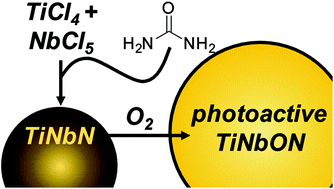当前位置:
X-MOL 学术
›
Dalton Trans.
›
论文详情
Our official English website, www.x-mol.net, welcomes your feedback! (Note: you will need to create a separate account there.)
Urea-glass preparation of titanium niobium nitrides and subsequent oxidation to photoactive titanium niobium oxynitrides
Dalton Transactions ( IF 4 ) Pub Date : 2017-08-31 00:00:00 , DOI: 10.1039/c7dt03077k James J. Brancho 1, 2, 3, 4 , Aaron D. Proctor 1, 2, 3, 4 , Shobhana Panuganti 1, 2, 3, 4 , Bart M. Bartlett 1, 2, 3, 4
Dalton Transactions ( IF 4 ) Pub Date : 2017-08-31 00:00:00 , DOI: 10.1039/c7dt03077k James J. Brancho 1, 2, 3, 4 , Aaron D. Proctor 1, 2, 3, 4 , Shobhana Panuganti 1, 2, 3, 4 , Bart M. Bartlett 1, 2, 3, 4
Affiliation

|
Titanium niobium oxynitrides (TiNbON) are an attractive category of potential photocatalysts, but strategies for preparing them remain limited. We adapt the wet chemical “urea glass” method for pure transition metal nitrides to single-phase mixed-metal titanium niobium nitrides for a range of niobium mole fractions. We then oxidize the nitrides by heating in air to prepare titanium niobium oxynitride that absorbs visible light of λ ≤ 550 nm. The materials are characterized by powder X-ray diffraction, scanning electron microscopy, and diffuse reflectance UV-vis spectroscopy. Their photochemical activity as a function of Nb fraction is benchmarked with methylene blue photomineralization promoted by full-spectrum AM 1.5G solar irradiation with and without a λ ≥ 400 nm cut-on filter. First-order Langmuir–Hinshelwood rate constants for photomineralization reveal a composition with ∼8% Nb to have superior reactivity. Full compositional analysis by Kjeldahl chemical nitrogen determination and energy-dispersive X-ray spectroscopy yields a chemical formula of Ti0.92Nb0.08O1.97N0.03. Finally, electron paramagnetic resonance spectroscopy correlates a localized Nb4+ defect with increased photochemical reaction rate.
中文翻译:

尿素玻璃制备氮化钛铌并随后氧化为光敏性氮氧化钛铌
氮氧化钛钛(TiNbON)是潜在的光催化剂的诱人类别,但制备它们的策略仍然有限。我们将用于纯过渡金属氮化物的湿化学“尿素玻璃”方法调整为适用于一定范围的铌摩尔分数的单相混合金属钛铌氮化物。然后,我们通过在空气中加热,以制备钛铌的氮氧化物,其吸收的可见光氧化氮化物λ ≤550纳米。该材料的特征在于粉末X射线衍射,扫描电子显微镜和漫反射紫外可见光谱。它们的光化学活性作为Nb分数的函数以全光谱AM 1.5G太阳辐射在有和没有λ的条件下促进的亚甲基蓝光矿化为基准≥400 nm截止滤光片。用于光矿化的一阶Langmuir-Hinshelwood速率常数显示,具有约8%Nb的成分具有出色的反应活性。通过凯氏定氮法和能量色散X射线光谱法对全部成分进行分析,得出化学式为Ti 0.92 Nb 0.08 O 1.97 N 0.03。最后,电子顺磁共振波谱将局部Nb 4+缺陷与增加的光化学反应速率相关联。
更新日期:2017-09-20
中文翻译:

尿素玻璃制备氮化钛铌并随后氧化为光敏性氮氧化钛铌
氮氧化钛钛(TiNbON)是潜在的光催化剂的诱人类别,但制备它们的策略仍然有限。我们将用于纯过渡金属氮化物的湿化学“尿素玻璃”方法调整为适用于一定范围的铌摩尔分数的单相混合金属钛铌氮化物。然后,我们通过在空气中加热,以制备钛铌的氮氧化物,其吸收的可见光氧化氮化物λ ≤550纳米。该材料的特征在于粉末X射线衍射,扫描电子显微镜和漫反射紫外可见光谱。它们的光化学活性作为Nb分数的函数以全光谱AM 1.5G太阳辐射在有和没有λ的条件下促进的亚甲基蓝光矿化为基准≥400 nm截止滤光片。用于光矿化的一阶Langmuir-Hinshelwood速率常数显示,具有约8%Nb的成分具有出色的反应活性。通过凯氏定氮法和能量色散X射线光谱法对全部成分进行分析,得出化学式为Ti 0.92 Nb 0.08 O 1.97 N 0.03。最后,电子顺磁共振波谱将局部Nb 4+缺陷与增加的光化学反应速率相关联。


























 京公网安备 11010802027423号
京公网安备 11010802027423号